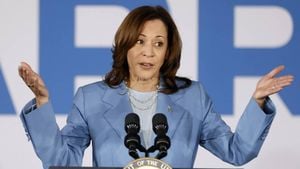Chinese President Xi Jinping has made headlines by inauguratively launching Chancay Port, a new 1.3 billion dollar deep-water facility on Peru's coast, during his recent state visit. Xi participated virtually alongside Peruvian President Dina Boluarte, celebrating not just the completion of the port but taking key steps forward for bilateral relations and China’s growing influence across Latin America.
The port, located about 48 kilometers north of Lima, stands as the first logistics hub operated by China in the region under the Belt and Road Initiative (BRI), which aims to strengthen global shipping networks. Notably, Chancay Port promotes expedited trade: it shortens shipping times to China from 35 days to just 23, reducing logistical costs by at least 20%. This venture is expected to generate roughly $4.5 billion annually for Peru and create over 8,000 jobs, hoping to position the country as a significant transportation hub linking South America with Asia.
During the virtual inauguration, Xi referred to Chancay Port as pivotal for creating a new maritime corridor between China and Latin America, expressing his aspiration to assure mutual economic growth. “We must build the Chancay project as a starting point to connect the Great Incas’ Trail with the new maritime land corridor,” he noted, emphasizing the historically inspired ambitions of both nations. Likewise, he highlighted the port as part of modernizing Peru’s infrastructure platform.
The significance of this launch cannot be understated. For many, it marks not just the opening of logistical routes but symbolizes China’s expanded reach and investment footprint in regions traditionally regarded as American spheres of influence. The buildup to the port's inauguration saw growing apprehension from U.S. officials, who believe this development could be leveraged for strategic military advantages.
President Boluarte, celebrating the project’s completion, stated, "With the new port, Peru will transform, becoming a world-class technological and industrial center." This transformation signalizes aspirations for Peru to develop economic ties beyond its traditional relationships and to embrace the potentials of the Asian marketplace.
The Chancay Port project has raised eyebrows within U.S. government circles, pointing to it as part of China's strategy to secure influence throughout Latin America. Analysts speculate this port—alongside developments such as projected rail links for transporting Brazilian commodities to Chancay—could drastically change trade flows and raise questions about American regional preparedness.
Symbolic of Peru's reliance on China, this port is more than just infrastructure; it embodies decades of close ties cemented through trade. China has been Peru's largest trading partner for over ten years. Recent figures reveal bilateral trade reached approximately $37.69 billion in 2023. The countries have collaborated on various projects, including free trade agreements, setting the tone for future ventures aligned with the BRI’s goals.
Peruvian representatives have expressed optimism about Chancay as more than just economic advancement; it aligns with the country’s objectives to diversify its exports to major players like China’s growing middle class. The value-added products sector is expected to thrive with improved access to Asian markets.
While Xi and Boluarte celebrated the port's operational prospects, it is imperative to address rising skepticism from various sectors. Observers argue concerns over foreign jurisdiction and exclusivity of operations might create vulnerabilities for Peru, especially as it surrenders substantial control over such strategic infrastructure to foreign investors.
It’s also difficult to ignore critiques on environmental grounds, relating to project risks and impacts concerning local ecosystems. Enhancements to the port come with pledges for sustainable practices; Chancay’s plans include provisions like rescue services for local wildlife.
This inauguration is set against the backdrop of Xi's broader diplomatic efforts, which include participation at the APEC Economic Leaders' Meeting also hosted this week, followed by travels to Brazil for the G20 Summit. Each destination intensifies dialogues focusing on trade and cooperation across the Pacific Rim.
Scholars and local residents alike have provided mixed reactions to this expansion. Many see it as beneficial, offering mediums for trade, jobs, and legacy projects between the two nations. Yet concerns linger about the geopolitical ramifications of deepening ties with China amid fears of increased oversight and influence.
While the Chancay Port serves as the centerpiece of President Xi's current Latin American push, it’s merely one part of a larger narrative enveloping U.S.-China relations and their extensive bi-coastal engagements. With both leaders anticipated to maintain steady coordination, analysts predict Chancay to be the beginning of advancements toward more comprehensive ties between China and Peru.
Down the road, the reception of Chancay's operations will likely be mixed, balancing economic potentials against the growing tide of geopolitical scrutiny. Whether hailed as visionary or critiqued as compromising, the ramifications of Xi's visit and Chancay's inception will shape countless future discussions surrounding international trade and local developments.



